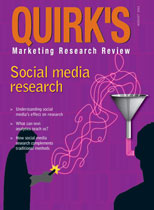Editor's note: This article appeared in the September 27, 2011, edition of Quirk's e-newsletter.
A Quick Response (QR) code is a specific matrix bar code (or two-dimensional code) that is readable by smartphones. In June 2011, 14 million mobile users in the U.S., representing 6.2 percent of the total mobile audience, scanned a QR code on their mobile device, according to a study from Reston, Va., research company comScore Inc. The study found that a mobile user who scanned a QR code during the month was more likely to be male (60.5 percent of code-scanning audience); skew toward ages 18-34 (53.4 percent); and have a household income of $100,000 or more (36.1 percent). Additionally, users are most likely to scan codes found in newspapers/magazines and on product packaging and do so while at home or in a store.
More than half of all QR code scanners were between the ages of 18-34 (53.4 percent). Those between the age of 25-34, who accounted for 36.8 percent of QR code scanners, were twice as likely as the average mobile user to engage in this behavior, while 18-to-24-year-olds were 36 percent more likely than average (index of 136) to scan. More than one-third of QR code scanners (36.1 percent) had a household income of at least $100,000, representing both the largest and most overrepresented income segment among the scanning audience.
The most popular source of a scanned QR code was a printed magazine or newspaper, with nearly half scanning QR codes from this source. Product packaging was the source of QR code-scanning for 35.3 percent of the audience, while 27.4 percent scanned a code from a Web site on a PC and 23.5 percent scanned codes from a poster/flyer/kiosk.
Among mobile users who scanned a QR code on their mobile devices in June, 58 percent did so from their home, while 39.4 percent did so from a retail store and 24.5 percent from a grocery store. Nearly 20 percent scanned a QR code while at work, while 12.6 percent did so outside or on public transit and 7.6 percent in a restaurant.
